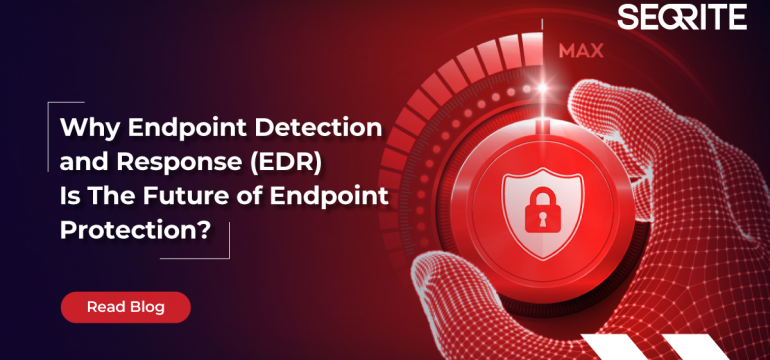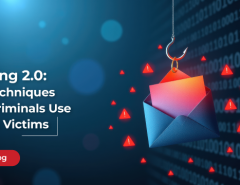Why Endpoint Detection and Response (EDR) Is The Future of Endpoint Protection?
Studies show that nearly 90% of cyberattacks and 70% of data breaches start at endpoint devices. Traditional security solutions like antivirus and firewalls are limited to detecting known threats and are ineffective against advanced attacks like social engineering, phishing, and ‘fileless’ attacks. These sophisticated threats can bypass traditional tools and remain hidden in networks, gathering data for future attacks. Endpoint Detection and Response (EDR) is more effective, offering advanced threat detection and automated responses that can identify and contain threats without human intervention. EDR also provides tools for security teams to discover, investigate, and prevent new threats.
What is Endpoint Detection and Response (EDR)?
Endpoint Detection and Response (EDR) is a comprehensive security solution that proactively monitors and analyzes the activities on endpoints, such as desktops, laptops, servers, and mobile devices, to identify and mitigate potential threats. Unlike traditional antivirus software, which primarily focuses on preventing known threats, EDR is designed to detect and respond to advanced, often stealthy, attacks that bypass perimeter defenses.
Key Capabilities of EDR
EDR solutions typically offer a range of capabilities that empower organizations to effectively detect, respond to, and mitigate cyber threats. Let’s explore some of the core functionalities of EDR:
Continuous Endpoint Monitoring: EDR solutions continuously collect and analyze data from endpoints, including processes, network connections, file activities, and user behaviors. This comprehensive data collection enables the system to detect anomalies and identify potential threats in real time.
Advanced Threat Detection: EDR utilizes a combination of techniques, such as signature-based detection, behavioural analysis, and machine learning, to identify known and unknown threats. By continuously updating threat intelligence and correlating data across endpoints, EDR can detect even the most sophisticated and stealthy attacks.
Automated Incident Response: When a threat is detected, EDR can initiate automated response actions to contain the threat and prevent it from spreading. These actions may include isolating the affected endpoint, terminating malicious processes, or quarantining suspicious files.
Threat Hunting and Forensics: EDR solutions often provide robust threat hunting and forensic capabilities, allowing security teams to proactively search for indicators of compromise (IOCs) and conduct in-depth investigations. This enables organizations to uncover hidden threats and gain a deeper understanding of the attack lifecycle.
Centralized Management and Reporting: EDR solutions typically offer a centralized management console that provides visibility into the security posture of the entire organization. This includes comprehensive reporting and dashboards that help security teams prioritize and respond to the most critical threats.
Integration with Other Security Tools: Many EDR solutions are designed to integrate with other security technologies, such as Security Information and Event Management (SIEM) systems, Security Orchestration, Automation, and Response (SOAR) platforms, and threat intelligence services. This integration enhances the overall security ecosystem and enables a more holistic approach to threat detection and response.
EDR vs. EPP: Understanding the Differences
Endpoint Protection Platforms (EPPs) and Endpoint Detection and Response (EDR) are both essential components of a comprehensive endpoint security strategy, but they serve distinct purposes.
Endpoint Protection Platforms (EPPs)
EPPs are primarily focused on preventing known threats from infiltrating the network. They typically employ traditional antivirus, anti-malware, and firewall technologies to block and detect known malware signatures and vulnerabilities. EPPs are effective at preventing common, file-based threats, but they often struggle to detect advanced, targeted attacks that bypass these perimeter defenses.
Endpoint Detection and Response (EDR)
In contrast, EDR solutions are designed to detect, investigate, and respond to advanced threats that have already penetrated the network. EDR solutions use more sophisticated techniques, such as behavioral analysis and machine learning, to identify anomalies and suspicious activities that may indicate the presence of a cyber threat. EDR also provides tools for security teams to conduct in-depth investigations and implement targeted remediation measures.
Complementary Approach
While EPPs and EDR serve different functions, they are often deployed together as part of a layered security approach. EPPs provide the first line of defense against known threats, while EDR complements this by detecting and responding to advanced, unknown threats that may have slipped through the perimeter.
The Benefits of Implementing EDR
Adopting an Endpoint Detection and Response (EDR) solution can provide organizations with a range of benefits, including:
Enhanced Threat Detection and Response
EDR’s advanced detection capabilities, coupled with its automated response mechanisms, enable organizations to identify and mitigate threats more effectively. This reduces the risk of successful cyber attacks and minimizes the potential impact on business operations.
Improved Incident Response Efficiency
By automating various incident response tasks, such as containment, investigation, and remediation, EDR solutions can significantly improve the efficiency of security teams. This allows organizations to respond to incidents more quickly and effectively, reducing downtime and minimizing the overall impact of a successful attack.
Increased Visibility and Situational Awareness
EDR solutions provide comprehensive visibility into the activities and behaviors of endpoints across the organization. This enhanced visibility enables security teams to gain a deeper understanding of the threat landscape, identify vulnerabilities, and make informed decisions to strengthen their security posture.
Better Compliance and Risk Mitigation
EDR solutions can help organizations meet regulatory compliance requirements by providing the necessary visibility, control, and reporting capabilities. This, in turn, reduces the risk of costly fines and penalties associated with data breaches and other security incidents.
Reduced Total Cost of Ownership (TCO)
By automating various security tasks, streamlining incident response processes, and minimizing the impact of successful attacks, EDR solutions can contribute to a lower total cost of ownership for an organization’s security infrastructure.
Protection of Intellectual Property and Critical Assets
EDR’s ability to detect and respond to advanced threats, including those targeting sensitive data and intellectual property, helps organizations safeguard their most valuable assets from theft or unauthorized access.
EDR in Action: Real-World Use Cases
Endpoint Detection and Response (EDR) solutions have proven their effectiveness in a variety of real-world scenarios. Let’s explore some common use cases:
Ransomware Defense: EDR solutions are particularly effective in detecting and containing ransomware attacks. By continuously monitoring endpoint activity and analyzing behavioural patterns, EDR can quickly identify and isolate ransomware infections, preventing them from spreading across the network and encrypting critical data.
Insider Threat Detection: EDR can help organizations detect and mitigate insider threats, such as employees or contractors engaged in data theft, sabotage, or unauthorized access. By analyzing user behaviour and identifying anomalies, EDR can alert security teams to suspicious activities and enable a swift response.
Advanced Persistent Threat (APT) Mitigation: EDR’s advanced threat detection capabilities are crucial in identifying and responding to Advanced Persistent Threat (APT) attacks. These sophisticated, targeted attacks often evade traditional security measures, but EDR’s ability to detect and investigate unusual activity can help organizations uncover and neutralize these threats.
Endpoint Protection for Remote and Mobile Workforce: As the shift towards remote and hybrid work continues, EDR solutions play a crucial role in securing endpoints that are outside the traditional corporate network. By extending visibility and control to these distributed devices, EDR helps organizations maintain a robust security posture, even in the face of a dispersed workforce.
Operational Technology (OT) Security: EDR solutions are increasingly being deployed in industrial and critical infrastructure environments to secure operational technology (OT) systems, such as industrial control systems and IoT devices. By adapting to the unique requirements of these environments, EDR can help organizations detect and respond to threats that could potentially disrupt critical operations.
Seqrite EDR – Shielding Endpoints, Securing Growth
Seqrite EDR (Endpoint Detection and Response) enhances security by constantly monitoring and collecting data from all endpoints. It is available in both on-premise and cloud-native versions. Seqrite EDR simplifies alert management and provides the visibility needed to identify and address complex threats without overwhelming security teams.
Seqrite EDR thoroughly analyzes telemetry events and blocks suspicious activities in real-time. It allows in-house teams to investigate attacks, reducing the need for outside help. With advanced data storage and threat intelligence, Seqrite EDR quickly uncovers hidden threats and enables rapid responses.
Key features of Seqrite EDR include:
- Multi-phase verification that examines system events using behavioral analysis, signature comparisons, and machine learning.
- Immediate host isolation that automatically or manually quarantines infected hosts.
- Automated and manual IOC lookups on historical data.
- An advanced notification system that integrates with SIEM solutions and sends SMS/email alerts.
- Dashboards and widgets that give a comprehensive view of system health and incidents.
- Detailed reports that provide insights aligned with MITRE TTPs.
- A rule builder that allows the creation of custom rules to detect unusual activity.
- Real-time response policies based on risk assessments.
- An investigative workbench for in-depth incident investigation.
- Incident management tools that help with remediation actions.
Conclusion
As the cybersecurity landscape continues to evolve, the role of EDR is expected to grow, with advancements in areas such as Extended Detection and Response (XDR), MDR, and the integration of Artificial Intelligence and Machine Learning. By carefully evaluating and selecting the right EDR solution, organizations can unlock the full potential of this powerful security technology and safeguard their critical assets from the ever-increasing threat of cyber-attacks.




